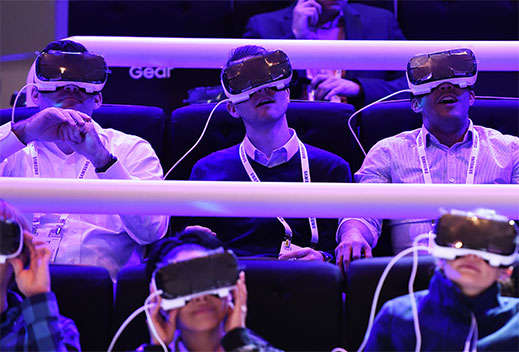Virtual Reality Is Exploding at Sundance, and Could Soon Be in Your News Feed
Chances are good that virtual reality isn’t part of your entertainment diet yet. But by the end of the year it will be if a cadre of filmmakers, game designers, and tech executives has anything to say about it.

At this year’s Sundance Film Festival, the number of VR entries has exploded, from just a few last year to more than two dozen. They run the gamut, inviting viewers into ghost stories, the lead role in a science fiction film, and walking alongside an Ebola survivor in West Africa. Facebook is pushing VR hard as well. The parent company of Oculus VR rolled out 360 Video in September and has already started releasing clips into users’ news feeds (including this ad for Stars Wars: The Force Awakens).
This is all possible because the hardware for both making and watching VR has matured by leaps and bounds in the past couple of years. For consumers, VR headsets are due out this year from the likes of Oculus, Sony, and a partnership between HTC and Valve. And smartphone-based models are already available. Late last year the Consumer Electronics Association forecast that 1.2 million VR headsets will be sold in 2016.
This missing link has been content—but now that it’s being filled in, it won’t be long until we get a glimpse of this immersive future.
(Source: The Verge, New York Times, Medium)
Keep Reading
Most Popular
Large language models can do jaw-dropping things. But nobody knows exactly why.
And that's a problem. Figuring it out is one of the biggest scientific puzzles of our time and a crucial step towards controlling more powerful future models.
The problem with plug-in hybrids? Their drivers.
Plug-in hybrids are often sold as a transition to EVs, but new data from Europe shows we’re still underestimating the emissions they produce.
Google DeepMind’s new generative model makes Super Mario–like games from scratch
Genie learns how to control games by watching hours and hours of video. It could help train next-gen robots too.
How scientists traced a mysterious covid case back to six toilets
When wastewater surveillance turns into a hunt for a single infected individual, the ethics get tricky.
Stay connected
Get the latest updates from
MIT Technology Review
Discover special offers, top stories, upcoming events, and more.